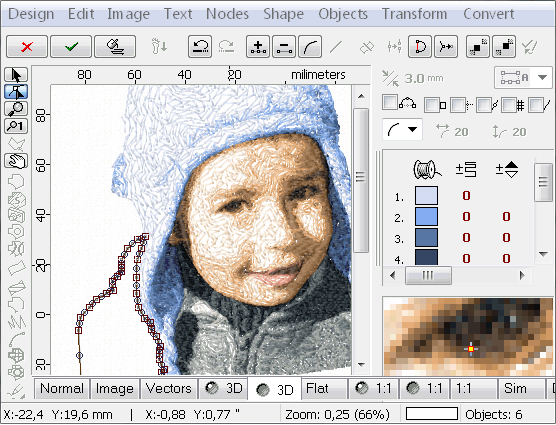Custom Digitizing for Embroidery: Tailored to Your Needs
Custom Digitizing for Embroidery: Tailored to Your Needs
Blog Article
Understanding the Embroidery Digitizing Refine: Your Ultimate Overview
Needlework digitizing is a precise craft that calls for accuracy and experience to translate elaborate layouts right into digital layouts for machine embroidery. As artisans embark on this trip to master the embroidery digitizing process, a comprehensive understanding of the fundamentals establishes the foundation for excellence. Beyond the fundamental knowledge exists a realm of advanced software, specialized tools, and nuanced methods waiting to be discovered. By diving into the nuances of digitizing, one can unlock a globe of creative possibilities and boost their needlework projects to brand-new heights.

Recognizing Needlework Digitizing Essentials
Embroidery digitizing basics develop the foundation whereupon detailed designs are converted right into machine-readable formats for specific stitching. This preliminary step in the needlework digitizing procedure is critical for guaranteeing that the last embroidered product is a loyal depiction of the initial layout. Comprehending needlework digitizing essentials entails comprehending essential principles such as stitch types, sew direction, density, padding, and pull payment.
Stitch types play an important function in identifying the aesthetic and textural outcome of the embroidered design. By choosing the appropriate stitch kind, whether it be satin, fill, or running stitch, digitizers can achieve the wanted result and enhance the general high quality of the needlework. Furthermore, stitch direction affects the flow and measurement of the design, while density establishes the spacing and protection of the stitches.
Additionally, underlay stitching offers security to the design by protecting the fabric and stopping distortion throughout the embroidery process. Draw payment is one more important consideration to combat the natural propensity of material to agreement when stitched. Mastering these embroidery digitizing fundamentals is fundamental for creating professional-quality stitched items.
Picking the Right Digitizing Software
Picking the proper digitizing software application is a crucial choice that dramatically affects the efficiency and high quality of the embroidery digitizing procedure. Digitizing for Embroidery. When picking the appropriate digitizing software program, it is necessary to think about aspects such as the complexity of designs you plan to create, the user-friendliness of the software application, the level of customer assistance supplied, and the compatibility with your needlework machine
There are different digitizing software application alternatives readily available out there, varying from basic programs for newbies to advanced software for professional digitizers. Some popular options consist of Wilcom EmbroideryStudio, Hatch Embroidery Software Application, and PulseID. These software application plans use a large range of tools and functions to aid you produce complex layouts with ease.
Prior to making a decision, it is a good idea to check out the different software alternatives with free tests or trials to figure out which one finest suits your needs. In addition, reviewing evaluations and seeking recommendations from seasoned digitizers can give useful insights right into the staminas and weak points of each software (Digitizing for Embroidery). By carefully check here reviewing your needs and comparing the attributes of various digitizing software, you can make an enlightened option that enhances your needlework digitizing workflow
Digitizing Devices and Methods

Optimizing Layout Setup for Needlework
Mastering the intricacies of layout setups is basic in attaining ideal cause the embroidery digitizing process, building upon the structure laid by recognizing digitizing devices and methods. When enhancing design settings for needlework, it is important to consider factors such as stitch type, thickness, padding, pull compensation, and registration. Sew kind choice impacts the overall look of the layout, with choices like satin, fill, and running stitches providing different appearances and impacts. Density refers to the spacing and density of stitches, impacting the design's coverage and resilience. Appropriate rug stitching provides security and stops textile distortion, especially for complicated designs his response or on stretchy products. Draw settlement adjusts for textile stretch throughout sewing, making certain precise style duplication. Registration settings align different components of the style precisely, preserving overall style integrity. By fine-tuning these style setups, embroiderers can improve the quality and accuracy of their stitched developments.

Troubleshooting Common Digitizing Issues
When experiencing common digitizing problems throughout the embroidery procedure, it is necessary to recognize the root triggers and execute reliable options without delay. One typical trouble is stitch density problems, where stitches might be as well thick, triggering the textile to tighten, or too sporadic, leading to gaps in the style. Readjusting the stitch thickness settings in the digitizing software can assist settle this issue.
One more regular obstacle is thread breaks during the needlework process. This can happen as a result of numerous reasons such as inaccurate stress setups, plain needles, or using low-quality thread. Making sure correct maintenance of the embroidery equipment, including routine needle modifications and stress adjustments, can lessen the incident of string breaks.
In addition, layout enrollment mistakes can cause misaligned components within the needlework layout. Checking the design alignment in the digitizing software and making necessary adjustments before stitching can aid in preventing this concern. By addressing these usual digitizing concerns without delay and effectively, you can make certain a smoother needlework procedure and high-grade ended up products.
Final Thought
Finally, mastering the needlework digitizing procedure needs a solid understanding of the basics, the appropriate option of software application, and understanding of tools and techniques. Maximizing layout settings and troubleshooting usual digitizing concerns are vital steps in guaranteeing top quality needlework outcomes. By complying with these actions faithfully, one can attain a knockout post accuracy and efficiency in the digitizing procedure.
Report this page